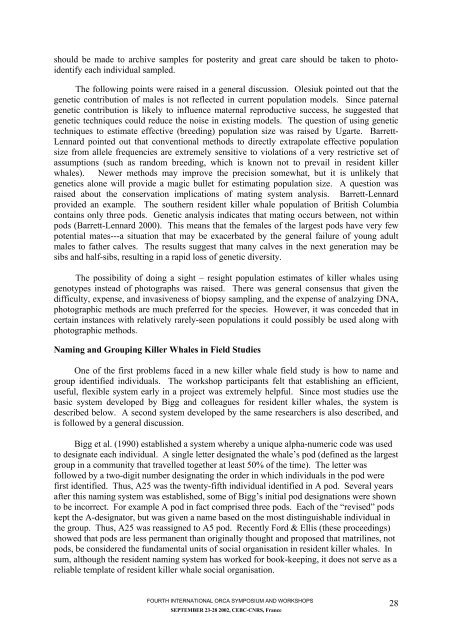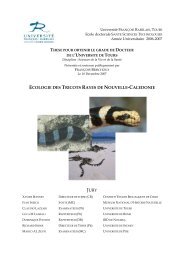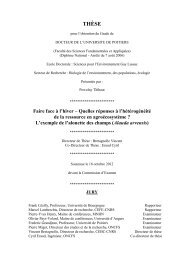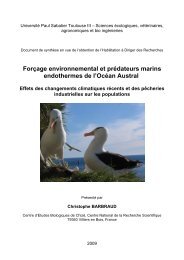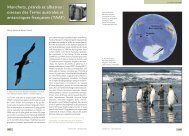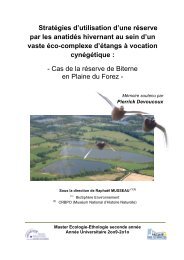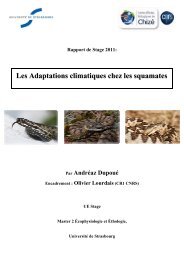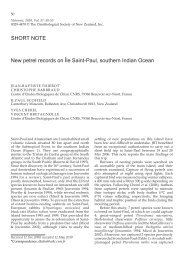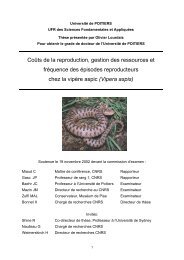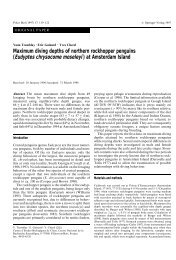Fourth International Orca Symposium and Workshop - CEBC - CNRS
Fourth International Orca Symposium and Workshop - CEBC - CNRS
Fourth International Orca Symposium and Workshop - CEBC - CNRS
Create successful ePaper yourself
Turn your PDF publications into a flip-book with our unique Google optimized e-Paper software.
should be made to archive samples for posterity <strong>and</strong> great care should be taken to photoidentify<br />
each individual sampled.<br />
The following points were raised in a general discussion. Olesiuk pointed out that the<br />
genetic contribution of males is not reflected in current population models. Since paternal<br />
genetic contribution is likely to influence maternal reproductive success, he suggested that<br />
genetic techniques could reduce the noise in existing models. The question of using genetic<br />
techniques to estimate effective (breeding) population size was raised by Ugarte. Barrett-<br />
Lennard pointed out that conventional methods to directly extrapolate effective population<br />
size from allele frequencies are extremely sensitive to violations of a very restrictive set of<br />
assumptions (such as r<strong>and</strong>om breeding, which is known not to prevail in resident killer<br />
whales). Newer methods may improve the precision somewhat, but it is unlikely that<br />
genetics alone will provide a magic bullet for estimating population size. A question was<br />
raised about the conservation implications of mating system analysis. Barrett-Lennard<br />
provided an example. The southern resident killer whale population of British Columbia<br />
contains only three pods. Genetic analysis indicates that mating occurs between, not within<br />
pods (Barrett-Lennard 2000). This means that the females of the largest pods have very few<br />
potential mates---a situation that may be exacerbated by the general failure of young adult<br />
males to father calves. The results suggest that many calves in the next generation may be<br />
sibs <strong>and</strong> half-sibs, resulting in a rapid loss of genetic diversity.<br />
The possibility of doing a sight – resight population estimates of killer whales using<br />
genotypes instead of photographs was raised. There was general consensus that given the<br />
difficulty, expense, <strong>and</strong> invasiveness of biopsy sampling, <strong>and</strong> the expense of analzying DNA,<br />
photographic methods are much preferred for the species. However, it was conceded that in<br />
certain instances with relatively rarely-seen populations it could possibly be used along with<br />
photographic methods.<br />
Naming <strong>and</strong> Grouping Killer Whales in Field Studies<br />
One of the first problems faced in a new killer whale field study is how to name <strong>and</strong><br />
group identified individuals. The workshop participants felt that establishing an efficient,<br />
useful, flexible system early in a project was extremely helpful. Since most studies use the<br />
basic system developed by Bigg <strong>and</strong> colleagues for resident killer whales, the system is<br />
described below. A second system developed by the same researchers is also described, <strong>and</strong><br />
is followed by a general discussion.<br />
Bigg et al. (1990) established a system whereby a unique alpha-numeric code was used<br />
to designate each individual. A single letter designated the whale’s pod (defined as the largest<br />
group in a community that travelled together at least 50% of the time). The letter was<br />
followed by a two-digit number designating the order in which individuals in the pod were<br />
first identified. Thus, A25 was the twenty-fifth individual identified in A pod. Several years<br />
after this naming system was established, some of Bigg’s initial pod designations were shown<br />
to be incorrect. For example A pod in fact comprised three pods. Each of the “revised” pods<br />
kept the A-designator, but was given a name based on the most distinguishable individual in<br />
the group. Thus, A25 was reassigned to A5 pod. Recently Ford & Ellis (these proceedings)<br />
showed that pods are less permanent than originally thought <strong>and</strong> proposed that matrilines, not<br />
pods, be considered the fundamental units of social organisation in resident killer whales. In<br />
sum, although the resident naming system has worked for book-keeping, it does not serve as a<br />
reliable template of resident killer whale social organisation.<br />
FOURTH INTERNATIONAL ORCA SYMPOSIUM AND WORKSHOPS<br />
SEPTEMBER 23-28 2002, <strong>CEBC</strong>-<strong>CNRS</strong>, France<br />
28


